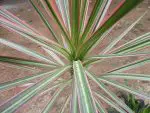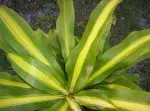This post contains affiliate links. If you buy something from one of our links we may earn a commission. Thanks
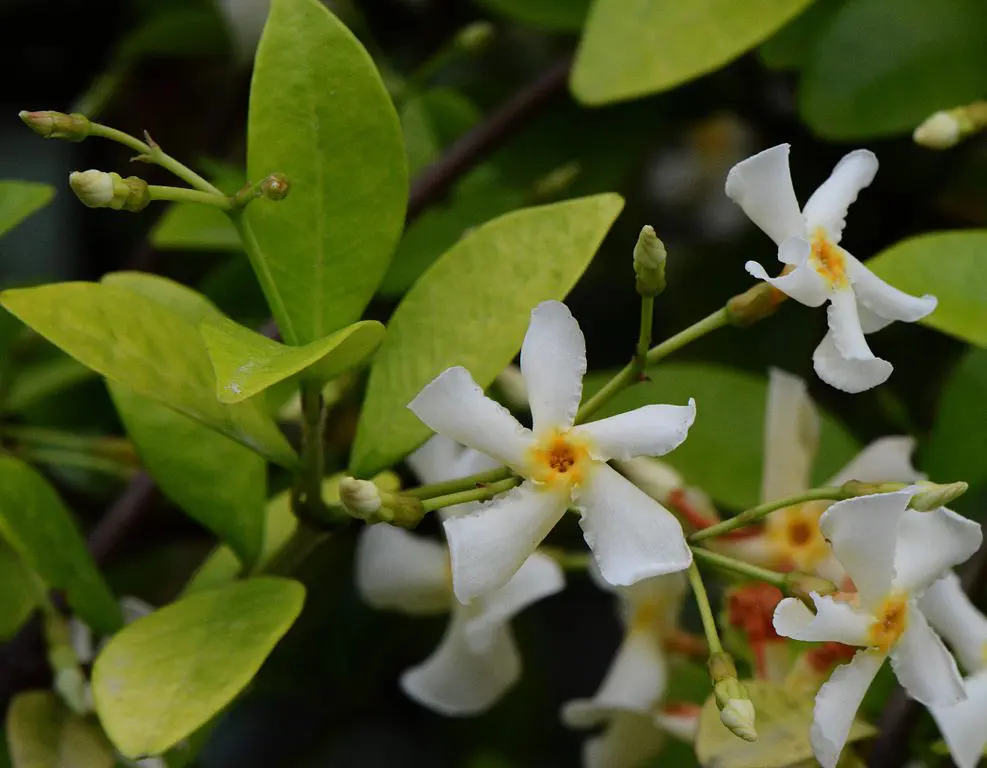
Discover the best tips and tricks for Asiatic Jasmine care with our comprehensive guide. From watering to pruning, we’ve got you covered!
Asiatic Jasmine is a hardy and versatile plant loved for its ability to create lush ground cover or climb structures. Basic care involves watering once a week, pruning in early spring, and fertilizing every four to six weeks during the growing season with a balanced fertilizer. Ensuring well-draining soil and keeping an eye out for common pests like mealybugs and aphids will help keep your Asiatic Jasmine thriving.
If you’re a plant lover, you may have heard about Asiatic Jasmine – a stunning groundcover that can add a touch of natural beauty to any garden or yard.
But what does Asiatic Jasmine care involve? This hardy plant is renowned for its low maintenance and ability to thrive in different conditions, making it a popular choice for both novice and experienced gardeners.
However, like any plant, Asiatic Jasmine requires some attention and care to keep it healthy and looking its best.
In this blog post, we’ll delve into everything you need to know about Asiatic Jasmine care so you can enjoy a flourishing garden with minimal effort.
You can buy Asiatic Jasmine here.
I. What Is Asiatic Jasmine?
Asiatic Jasmine is a popular choice among gardeners and landscapers for its lush green foliage and low maintenance requirements.
Whether you’re looking for an excellent ground cover to adorn your garden or a vine to climb up a wall it’s a good choice. It can also be used in container gardens.
Asiatic Jasmine can add an appealing natural touch to any outdoor space. However, to keep your Asiatic Jasmine healthy and thriving, it’s essential to know how to properly care for it.
In this blog post, we’ll cover everything you need to know about Asiatic Jasmine care, from watering to pruning to fertilizing and more. So, let’s dive in and learn how to keep your Asiatic Jasmine looking its best!
Trachelospermum asiaticum, the Asiatic jasmine, is a species of flowering plant in the family Apocynaceae and it is native to Asia. Its flowers resemble stars, so it is also referred to as yellow star jasmine or Asian star jasmine. This is a fast growing evergreen vine, often used to cover fences, walls, and similar surfaces. It is heat- and cold- tolerant, and grows even in shady areas. https://en.wikipedia.org/wiki/Trachelospermum_asiaticum
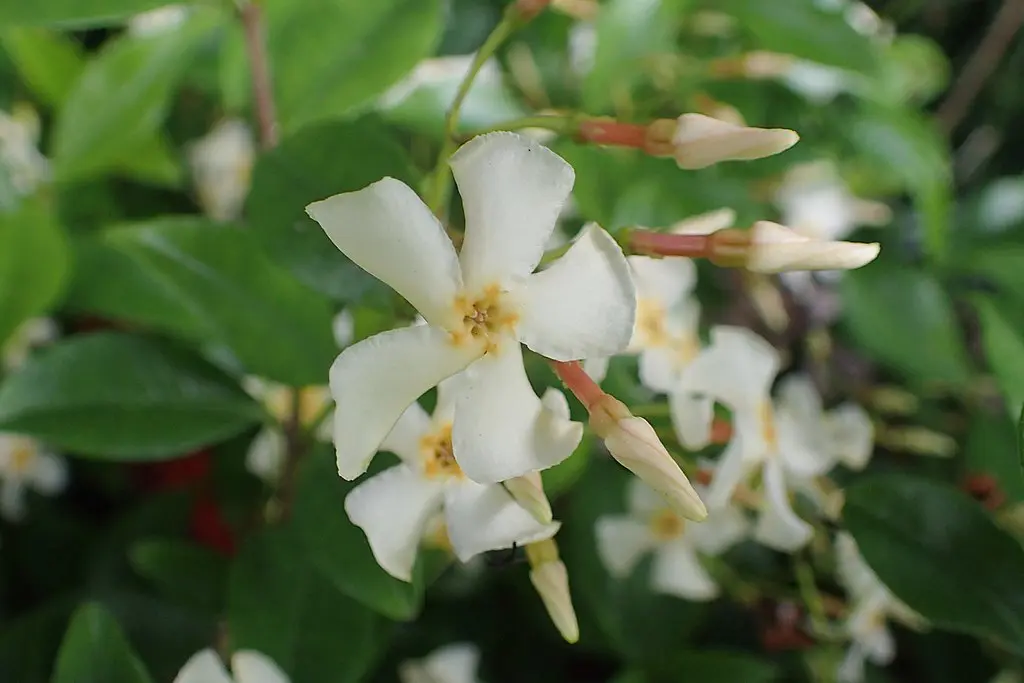
Asiatic Jasmine Benefits:
Asiatic Jasmine, also known as Trachelospermum Asiaticum or dwarf Confederate jasmine, is a small evergreen plant that is native to Asia.
It has shiny, oval-shaped glossy leaves that are deep green in color and produces small white star-shaped flowers that have a sweet fragrance.
Asiatic Jasmine is an excellent evergreen groundcover option as it can quickly spread and create a thick mat and dense layer of greenery.
It is also suitable for climbing walls, trellises, and fences.
Besides its aesthetic appeal, Asiatic Jasmine has several benefits. It helps to reduce soil erosion, keeps the soil cool, and suppresses weed growth, making it an ideal choice for slopes and hillsides.
It is also low-maintenance and can survive in a wide range of soil conditions, making it suitable for a variety of landscapes from full sun to partial shade.
Importance of Caring for your Asiatic Jasmine:
While Asiatic Jasmine is a hardy plant that requires little attention, it still needs regular care to stay healthy and look its best.
Neglecting your Asiatic Jasmine can lead to pest infestations, fungal diseases, and stunted growth.
Caring for your Asiatic Jasmine involves regular watering, pruning, and fertilizing. Watering should be done consistently to ensure that the soil is not too dry or too wet.
Pruning should be done to keep the plant at the desired shape and size and to promote new growth.
Fertilizing should be done once or twice a year to keep the plant healthy and encourage blooming.
By providing proper care for your Asiatic Jasmine, you can enjoy a beautiful, lush garden without much effort.
Different Jasmine Plants
Common names are often confusing and Asian jasmine plants are not true jasmine (Jasminum officinale) but are a climbing vine with fragrant flowers suitable for mass plantings.
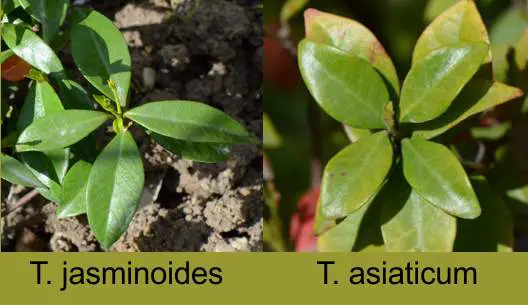
Jasminum officinale, also known as common jasmine, is a woody, deciduous, or evergreen vine that is native to Iran but is also commonly cultivated throughout Europe and North America.
It has fragrant white flowers that bloom in mid to late summer and is often used as a ground cover or a climber for trellises and walls.
Trachelospermum jasminoides, also known as Confederate or star jasmine, is a woody, evergreen vine or ground cover that is native to China and Japan but is also cultivated widely in other parts of the world.
T. jasminoides is also known as Primrose jasmine, Yellow star jasmine, or Japanese star jasmine. It has fragrant white flowers that bloom in late spring or early summer and is often used as a ground cover or climber for trellises and walls.
Trachelospermum asiaticum, also known as Asiatic jasmine, is an evergreen ground cover that is native to Japan, China, and Korea.
T. asiaticum or Asian star jasmine has glossy green leaves and small, white, fragrant flowers that bloom in the late spring and early summer.
It is often used as a ground cover or as a low-maintenance alternative to grass in areas with partial or full shade.
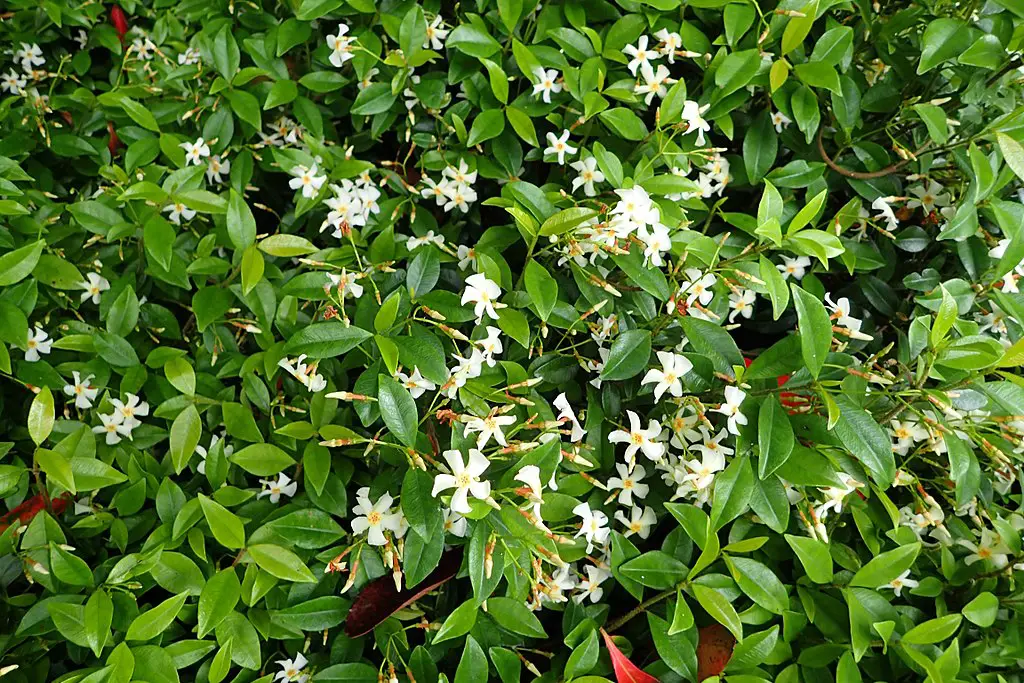
USDA hardiness zones for Asiatic jasmine
Asiatic Jasmine is a hardy plant that can tolerate a wide range of temperatures. It is typically grown in USDA Hardiness Zones 7 to 10, although it can also be grown in Zone 6 with protection in the form of mulch or frost blankets during winter.
In Zone 7, temperatures can dip as low as 0 to 10 degrees Fahrenheit (-17.8 to -12.2 degrees Celsius) during the winter, while in Zone 10, temperatures can remain above 30 degrees Fahrenheit (-1.1 degrees Celsius) even in the coldest months.
When planting Asiatic Jasmine, it is important to select a variety that is well-suited to your specific zone to ensure the best chances of success.
What is the best soil for Asiatic jasmine?
Asiatic Jasmine can grow in a wide range of soils but it thrives in well-draining soil that is rich in organic matter.
A good soil mix for Asiatic Jasmine is one that is loamy and slightly acidic with a pH range of 5.5 to 6.5.
Avoid using heavy clay soils, as they can retain too much moisture and lead to root rot.
You can amend heavy soils and create a suitable soil mix for Asiatic Jasmine by combining equal parts of peat moss, perlite, and compost.
This mixture will provide good drainage while retaining enough moisture and nutrients for your plant to thrive.
Additionally, it is a good idea to amend any soil with organic matter, such as compost or aged manure, to improve its texture and fertility.
Watering
Watering is an essential aspect of maintaining your Asiatic Jasmine plant. Proper watering ensures that the plant receives the necessary nutrients to stay healthy and green.
However, watering Asiatic Jasmine can be tricky, and improper watering can lead to yellowing leaves, root rot, and even death.
In this section, we will discuss the ideal watering conditions for Asiatic Jasmine, how often to water it, and tips for watering your plant to ensure its optimal growth and health. So, if you want to keep your Asiatic Jasmine thriving, keep reading!
Ideal Watering Conditions for Asiatic Jasmine:
Asiatic Jasmine prefers to grow in well-drained soil that does not retain too much water.
This is because too much moisture in the soil can lead to root rot and other fungal diseases.
Additionally, the plant needs regular watering to prevent it from becoming too dry.
Ideally, the soil should be kept moist, but not waterlogged, as too much water can be just as damaging as too little.
Avoid heavy or wet soils and plant them in soil with good drainage.
How Often to Water Asiatic Jasmine:
The frequency of watering your Asiatic Jasmine depends on several factors such as the soil type, weather conditions, and the age of the plant.
Young plants require more frequent watering than established ones, and sandy soil dries out faster than loamy soil.
As a general rule of thumb, Asiatic Jasmine should be watered once a week during the growing season, and every two to three weeks during the dormant season.
Many areas may have enough natural rainfall but rain is often scare during the warmer summer months when plants need it most.
Tips for Watering Asiatic Jasmine:
To avoid overwatering or underwatering your Asiatic Jasmine, you should follow some tips.
Water the plant deeply but less frequently, ensuring that the soil is evenly moist.
Also, water the plant early in the morning or late in the afternoon when temperatures are cooler to prevent the water from evaporating too quickly.
Finally, monitor your plant for signs of overwatering or underwatering, such as yellowing leaves or wilting, and adjust your watering schedule accordingly.
By following these tips, you can ensure that your Asiatic Jasmine receives the proper amount of water to keep it healthy and lush.
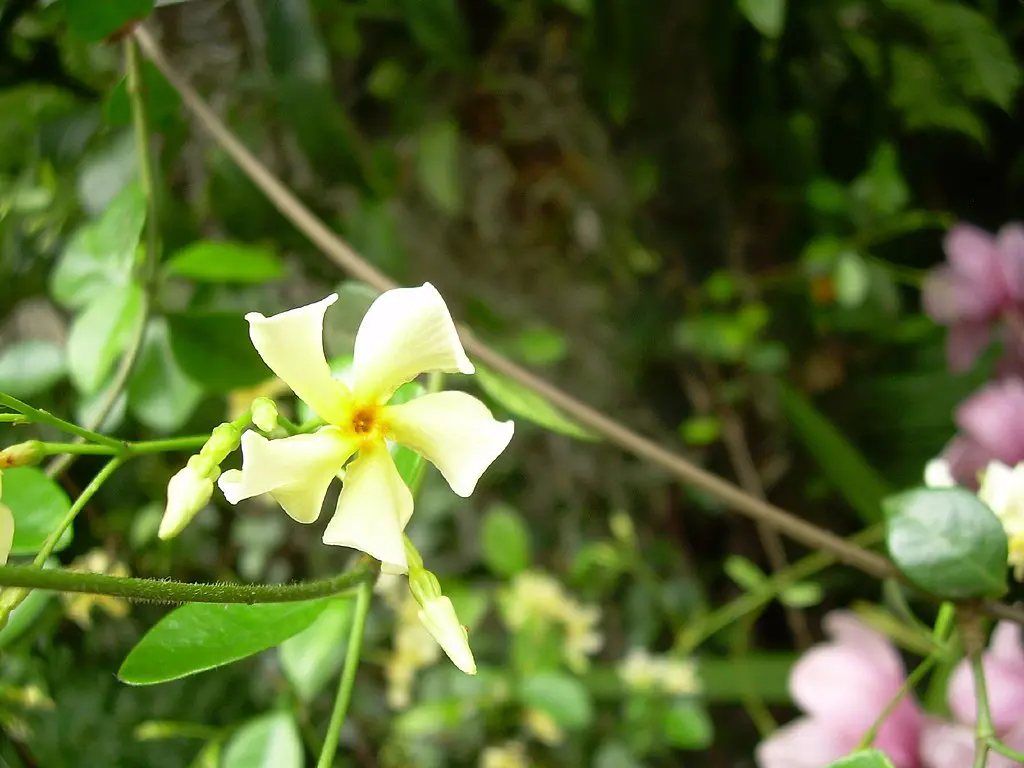
Pruning and Maintenance
Pruning and maintenance are vital components of caring for your Asiatic Jasmine.
Regular pruning helps to maintain the plant’s shape and size, promote healthy growth, and prevent pest infestations.
Additionally, maintenance tasks such as fertilizing and pest control can ensure that your plant thrives and stays beautiful all year round.
In this section, we will discuss the benefits of pruning and maintenance, when to perform these tasks, and tips for keeping your Asiatic Jasmine healthy and looking its best.
So, let’s dive into the world of pruning and maintenance for Asiatic Jasmine!
Reasons for Pruning Asiatic Jasmine:
Pruning Asiatic Jasmine serves several purposes, including maintaining the plant’s size and shape, promoting healthy growth, and preventing pest infestations.
Pruning also helps to remove dead or damaged branches, which can be a breeding ground for disease and pests.
Additionally, pruning can improve air circulation and sunlight penetration, which are crucial for the plant’s overall health.
When to Prune Asiatic Jasmine:
The best time to prune Asiatic Jasmine is in early spring, just before the growing season begins.
This allows the plant to produce new growth and recover from pruning quickly.
You can also perform light pruning throughout the growing season to control the plant’s size and shape, as needed.
How to Properly Prune Asiatic Jasmine:
To properly prune Asiatic Jasmine, start by removing any dead, damaged, or diseased branches.
Then, prune back any branches that are growing too long or out of shape, making sure to cut just above a healthy bud or leaf.
Avoid cutting into the woody part of the plant, as this can damage the plant and prevent new growth.
Additionally, be sure to use clean, sharp pruning tools to avoid injuring the plant or spreading disease.
In addition to pruning, proper maintenance of Asiatic Jasmine includes regular fertilization and pest control.
Fertilize your plant once a month during the growing season with a balanced fertilizer to promote healthy growth.
For pest control, monitor your plant regularly for signs of infestation and treat it as needed with insecticidal soap or neem oil.
By following these tips, you can ensure that your Asiatic Jasmine is properly pruned and maintained, promoting healthy growth and a beautiful appearance.
IV. Fertilizing
Fertilizing is an essential part of caring for your Asiatic Jasmine. Providing your plant with the proper nutrients helps promote healthy growth, vibrant foliage, and beautiful blooms.
However, it can be tricky to know what type of fertilizer to use and when to apply it.
In this section, we will discuss the benefits of fertilizing your Asiatic Jasmine, the best types of fertilizers to use, and when and how to apply them.
So, let’s dive into the world of fertilizing Asiatic Jasmine!
Importance of Fertilizing Asiatic Jasmine:
Fertilizing is crucial for maintaining the health and beauty of your Asiatic Jasmine. Providing your plant with the right nutrients helps it grow strong, healthy, and vibrant.
Additionally, fertilizing can encourage your plant to produce more blooms and foliage, resulting in a more attractive and eye-catching appearance.
Types of Fertilizers for Asiatic Jasmine:
When it comes to fertilizing Asiatic Jasmine, there are several types of fertilizers to choose from, including organic and synthetic options.
Organic fertilizers, such as compost or manure, are ideal for those who prefer a natural approach.
Synthetic fertilizers, on the other hand, provide a quick source of nutrients and are more convenient for those with busy schedules.
Choose a balanced fertilizer with equal parts nitrogen, phosphorus, and potassium for optimal growth.
How to Apply Fertilizer to Asiatic Jasmine:
A water-soluble fertilizer applied with a hose-end sprayer is the easiest way to cover larger areas.
Fertilizer granules can be scattered over the area. You will want to make sure to water it in and get it off the leaves or they could get burned.
To properly fertilize your Asiatic Jasmine, start by watering the plant thoroughly.
Then, apply the fertilizer according to the package instructions, being careful not to apply too much.
Over-fertilizing can lead to burned leaves and damage to the plant. Apply fertilizer every four to six weeks during the growing season, from spring through fall.
Avoid fertilizing during the winter months when the plant is dormant.
In addition to proper fertilization, be sure to monitor your plant for signs of nutrient deficiency, such as yellowing leaves or stunted growth.
Adjust your fertilization schedule or type of fertilizer as needed to maintain optimal health. Try to use a complete fertilizer that contains essential micronutrients too.
By following these tips, you can ensure that your Asiatic Jasmine is properly fertilized, promoting healthy growth and a beautiful appearance.
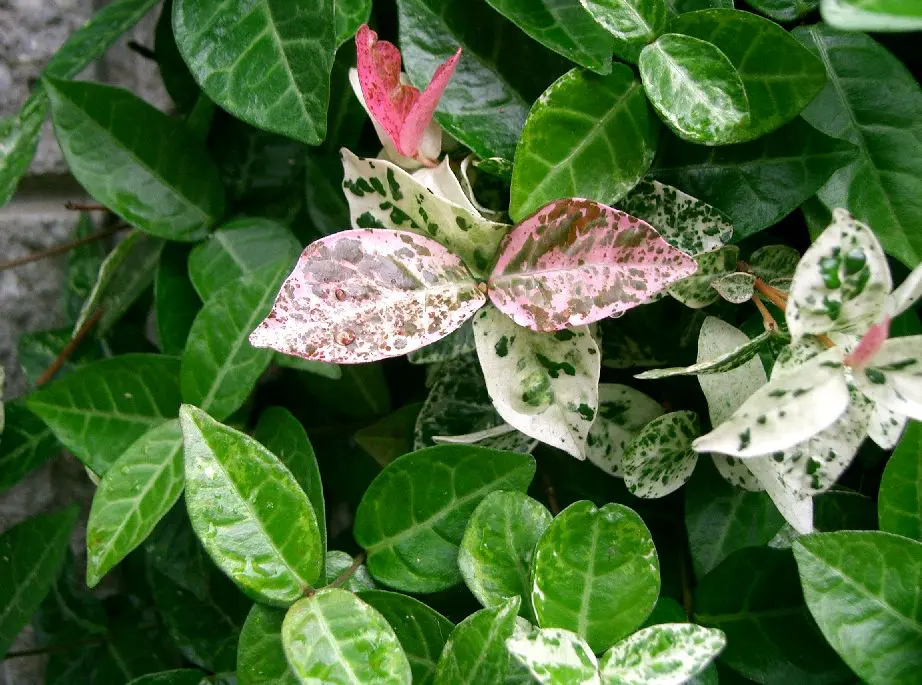
V. Pests and Diseases
Asiatic Jasmine is a hardy plant, but it is still susceptible to pests and diseases like any other plant.
In this section, we will discuss common pests and diseases that can affect your Asiatic Jasmine and how to identify and treat them.
By learning about the potential issues and how to prevent or treat them, you can keep your Asiatic Jasmine healthy and thriving.
So, let’s take a closer look at how to prevent and address common pests and diseases in Asiatic Jasmine.
Common Pests That Affect Asiatic Jasmine:
Asiatic Jasmine can be vulnerable to various pests, including mealybugs, scale insects, spider mites, and aphids.
These pests can cause leaf yellowing, stunted growth, and even death of the plant if left untreated.
It’s important to identify the pest causing the damage to choose the appropriate treatment.
Signs of Pest Infestations and Diseases:
Signs of pest infestations on Asiatic Jasmine include yellowing or stippling of leaves, webbing, and visible insects.
Diseases like root rot and leaf spot can cause wilting or discoloration of leaves, and in severe cases, death of the plant.
Regularly inspect your Asiatic Jasmine for signs of pests or diseases, especially during the growing season.
How to Treat and Prevent Pests and Diseases in Asiatic Jasmine:
Treatment options for pests and diseases depend on the type of pest or disease affecting your plant.
Insecticidal soap, neem oil, or horticultural oils can be effective treatments for common pests.
For diseases, it is best to remove infected leaves and avoid overwatering or allowing the plant to sit in water.
Maintaining proper care, such as watering and fertilization, can help prevent future infestations and diseases.
Additionally, preventive measures like keeping the plant clean and avoiding overcrowding can help keep pests and diseases at bay.
Regular pruning, air circulation, and avoiding over-fertilizing can also help keep the plant healthy.
By being aware of the common pests and diseases that can affect Asiatic Jasmine, monitoring your plant regularly, and taking appropriate measures to treat or prevent them, you can keep your plant healthy and thriving.
VI. Wrapping Up
Congratulations on making it to the end of this guide on Asiatic Jasmine care!
By now, you should have a better understanding of how to care for your Asiatic Jasmine, from watering and pruning to fertilizing and pest control.
With the proper care and attention, your Asiatic Jasmine can thrive and bring beauty to your home or garden for years to come.
Remember to keep an eye on your plant’s needs and adjust your care accordingly. And most importantly, enjoy the process of caring for your Asiatic Jasmine!
Asiatic Jasmine FAQs:
The world of Asiatic Jasmine is enchanting yet comes with its set of inquiries. Below are some frequently asked questions and answers that could aid your gardening journey with this resilient plant.
Q. How often should Asiatic Jasmine be watered?
A. Watering should be performed once a week during the growing season and every two to three weeks during the dormant season, ensuring the soil remains moist but not waterlogged.
Q. When is the best time to prune Asiatic Jasmine?
A. Early spring is the ideal time for pruning Asiatic Jasmine to promote new growth, although light pruning can be done throughout the growing season to maintain shape and size.
Q. What type of fertilizer is suitable for Asiatic Jasmine?
A. A balanced fertilizer, with equal parts nitrogen, phosphorus, and potassium, is suitable for Asiatic Jasmine. Apply every four to six weeks during the growing season.
Q. How can pests and diseases be treated in Asiatic Jasmine?
A. For pest control, use insecticidal soap or neem oil. For diseases like root rot, ensure proper watering practices, and remove infected leaves to prevent further spread.
Final Thoughts on Asiatic Jasmine Care:
Asiatic Jasmine is a beautiful and versatile plant that can enhance any indoor or outdoor space.
With proper care, your Asiatic Jasmine can live for years and bring joy and beauty to your home or garden.
From watering and pruning to fertilizing and pest control, taking care of your Asiatic Jasmine requires attention and care.
But by following the tips and guidelines provided in this guide, you can ensure that your plant remains healthy and beautiful for years to come.
Remember to be patient, observe your plant regularly, and adjust your care accordingly. And most importantly, enjoy the process of caring for your Asiatic Jasmine!
You can buy Asiatic Jasmine here.
Get more Backyard Gardening Ideas




